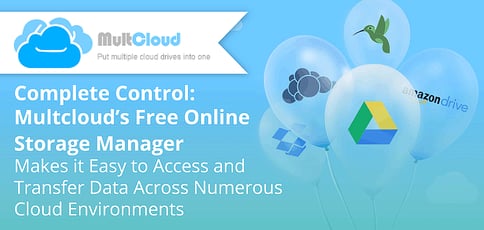
TL; DR: Whether used for work or at home, a range of online storage services have become a part of our daily lives. But keeping track of countless files on different cloud platforms is a hassle at best. MultCloud, a multiple cloud storage manager, enables users to access and transfer data across online storage services with a single login. With ongoing improvements based on user feedback and new products, including a mobile app, on the way, MultCloud is prepared to make what was once a cumbersome process increasingly simple.
In many ways, cloud storage still feels like a fresh concept, evoking imagery of files cocooned within fluffy white pillows.
But consider all of the online clutter you’ve accumulated over the years — school papers on Google Drive, client files on Dropbox, photos stashed on Flickr, bits and bobs on Evernote — and the cloud begins to seem more like a dusty attic.
Thankfully, services like MultCloud are now available to help us preserve and organize valuable files within our online messes. The multiple cloud storage manager brings together more than 30 of the most popular online drives under one virtual roof and allows for seamless cloud data transfer.

MultCloud allows users to effortlessly preside over a range of online storage services.
“Online storage services are becoming increasingly useful in our daily lives, and many people have more than one cloud drive account,” Catherine, MultCloud’s Marketing Associate, told us. “MultCloud is a web-based cloud manager that enables you to transfer data across clouds or online storage services (such as Google Drive, Dropbox, OneDrive, Box, MEGA, etc.) and access all your online files with a single login.”
Many of MultCloud’s services are free, with premium upgrades available for those who require additional resources. More importantly, the platform comes backed by strict data protection measures, including 256-bit encryption for transfers. With ongoing development spurring new products like a handy mobile app, MultCloud is prepared to make it easier for users to combine multiple cloud storage environments.
Oversee More Than 30 Supported Cloud Services with a Single Login
Catherine told us that the professional team behind MultCloud began development on the project in 2012. Six years later, she said staff still feel like they’re just getting started — because they’re continually reimagining the service to meet high usability standards. “If we have an underlying tenet, it’s that our services must be easy to use, even for nonprofessionals,” Catherine said.
That’s why MultCloud employs a drag-and-drop approach to cloud management that makes it easy to organize images, videos, and documents from different providers within a single interface and login. The combined environment makes searching for files across cloud services unbelievably simple.
The service also enables users to maximize free cloud storage by combining small amounts of storage from multiple providers into one umbrella account. By merging these limited but free drives, MultCloud creates a workaround that ultimately provides an unlimited cloud storage solution at no cost.

Better together: MultCloud merges popular cloud storage accounts to create a powerful master platform.
In addition to managing accounts from different providers, MultCloud allows users to take control of multiple accounts from the same service. For example, between school, work, and our personal lives, many of us have more than one Google Drive account. MultCloud makes it easy to manage files from such accounts simultaneously, as well as transfer files between them. MultCloud also supports FTP to FTP functionality.
If multiple users need access to one MultCloud account, the primary account owner can create sub-accounts with various permissions as well as manage those sub-accounts from a single interface. It’s as simple as sending a username and password to another person who may then log in to access the shared folders.
A Secure Way to Save Time and Eliminate Data Transfer Headaches
Between Facebook exposing the personal information of 50 million users and Google giving outside developers access to Google+ data, 2018 has been a rough year in terms of online security. It’s no wonder that recent studies indicate that just 23% of organizations fully trust the security of public clouds — even while cloud adoption is growing.
If you’re (understandably) concerned about keeping data private, MultCloud has a solution through 256-bit encryption in data transmission and an open protocol to allow secure authorization. Based on OAuth, a standard authorization framework that enables third-party apps to obtain limited access to some cloud accounts, the protocol safely provides centralized cloud management. “MultCloud guarantees the security of private data to ensure users are at peace,” Catherine said.

Transfer, sync, and combine multiple cloud services into one drive with MultCloud.
Their worries aside, users become liberated to transfer files between cloud services quickly and easily. “The #1 advantage of MultCloud is that it can save users time to transfer files from one cloud account to another,” Catherine said. “Without MultCloud, users have to log in to their source cloud to download target files to local storage, then log in to their destination cloud. From there, they have to upload the target files from the local system to the destination cloud — which is all very time-consuming.”
In addition to transfers, MultCloud enables users to sync data between cloud environments at regular intervals or at specified times. “The cloud sync feature is extremely useful,” Catherine said. “For example, you can ensure your work documents in Dropbox are the same as in your Google Drive (a one-way sync) or keep certain files both in Dropbox and Google Drive (a two-way sync).”
Once a cloud-to-cloud transfer or sync begins, the user can simply shut down his or her browser or computer, and MultCloud will complete the task offline. Looking to make the process even easier? MultCloud’s free Google Chrome extension allows users to monitor file transfers between clouds at any moment — all while you browse the web.
Freeware and Expanded Features with Premium Upgrade Options
MultCloud aims to keep the majority of its services free in an effort to promote access to as many users as possible. Catherine told us that’s been the company’s goal from the beginning, and it intends to keep up the good work. At the same time, MultCloud offers premium options for advanced users in need of additional resources.
The company’s free plan, for example, allows for 50GB of data traffic, in total, to transfer or sync data between cloud storage services per month. If the user requires additional traffic, they will have the option to upgrade to the subscriber plan, which is billed at $9.90 monthly, $24.90 quarterly, or $89.90 yearly.
The free plan offers one-way and two-way synchronization, while the paid plans offer eight synchronization modes, including custom options and support for incremental backups. Paid plans also feature higher-quality servers and customer support. While the company would prefer to provide all services at no cost, the increasing popularity of cloud drive storage necessitates ongoing technical investments.
“These situations have required us to improve our technology all the time,” Catherine said. “Our paid plans allow us to offer satisfactory speeds, enable simultaneous multi-server transfers, and guarantee a safer environment through 256-bit AES encryption,” Catherine said.
Ongoing Development and an Upcoming Mobile App
Catherine told us MultCloud bases at least 80% of its product development process on adapting to new trends and listening to customer feedback. “For instance, the idea of adding a certain new cloud drive to our service comes mostly from customer requirements,” she said.
As far as what’s on the horizon, MultCloud is working hard to launch a mobile app that will make it easier than ever for the company to live up to its tagline: “Put multiple cloud drives into one.” Catherine said the app will make the data transfer process possible with just the swipe of a finger. The creators of MultCloud have also created eBackupper — a one-click service that allows for quick and easy backup of webites and databases to a user’s own cloud services.
Laudably, Catherine said MultCloud’s goal isn’t to be the biggest, most powerful company on the market — it’s to be the most responsible one.
“Our team works hard to make MultCloud better — to make it more useful, easy, and safe for our users,” she said. With goals like these, we see pristine futures for many attic-like cloud environments.
HostingAdvice.com is a free online resource that offers valuable content and comparison services to users. To keep this resource 100% free, we receive compensation from many of the offers listed on the site. Along with key review factors, this compensation may impact how and where products appear across the site (including, for example, the order in which they appear). HostingAdvice.com does not include the entire universe of available offers. Editorial opinions expressed on the site are strictly our own and are not provided, endorsed, or approved by advertisers.
Our site is committed to publishing independent, accurate content guided by strict editorial guidelines. Before articles and reviews are published on our site, they undergo a thorough review process performed by a team of independent editors and subject-matter experts to ensure the content’s accuracy, timeliness, and impartiality. Our editorial team is separate and independent of our site’s advertisers, and the opinions they express on our site are their own. To read more about our team members and their editorial backgrounds, please visit our site’s About page.

